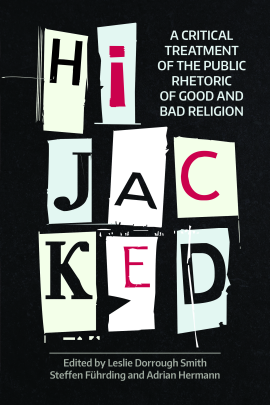
Hijacked
A Critical Treatment of the Public Rhetoric of Good and Bad Religion
Leslie Dorrough Smith, Steffen Fuhrding, Adrian Hermann
Whether intentionally or not much of our public discourse on religion involves a subtle, but incredibly powerful, distinction between "good" and "bad" religion. The implications of these labeling practices are far-reaching, indeed, for such judgments manifest in terms such as "fundamentalist," "r... Read more
Published: 2020
Pages: 234
eBook: 9781781797266
Whether intentionally or not much of our public discourse on religion involves a subtle, but incredibly powerful, distinction between "good" and "bad" religion. The implications of these labeling practices are far-reaching, indeed, for such judgments manifest in terms such as "fundamentalist," "radical," and "extremist," words that are often the gauge by which governments worldwide determine everything from the parameters of religious freedom, to what constitutes an act of terrorism, to whether certain groups receive legal protections. Conversely, it is often surprising to see how different groups that may otherwise better typify the extremist profile remain unscathed by punitive governmental or social measures because of their pre-existing social popularity or perceived normalcy. This volume argues that public inquiry into religion is guided by unspoken value judgments, which are themselves the products of rarely-discussed political interests. This volume opens with a critical introduction which lays out the nature of the issue and its practical ramifications. The following chapter demonstrates how one can analytically critique the good/bad religion rhetoric as it appears in scholarship today. Hijacked is then organized around four different social institutions through which these value judgments have been established and deployed - namely, within politics, the media, the university, and the classroom. After a short introduction by the editors, each section begins with a chapter that highlights a particular case study or example of this good/bad distinction at work. The three to four responses that follow extrapolate from some element of the exemplar to provide an analysis on how such rhetoric operates in that particular social realm.
| Cover | Cover | ||
|---|---|---|---|
| Contents | v | ||
| Preface | vii | ||
| Introduction to Part I | 1 | ||
| Chapter 1 | 3 | ||
| Chapter 2 | 12 | ||
| Chapter 3 | 23 | ||
| Introduction to Part II | 35 | ||
| Chapter 4 | 37 | ||
| Chapter 5 | 48 | ||
| Chapter 6 | 56 | ||
| Chapter 7 | 61 | ||
| Introduction to Part III | 69 | ||
| Chapter 8 | 71 | ||
| Chapter 9 | 87 | ||
| Chapter 10 | 98 | ||
| Chapter 11 | 108 | ||
| Chapter 12 | 118 | ||
| Introduction to Part IV | 127 | ||
| Chapter 13 | 129 | ||
| Chapter 14 | 150 | ||
| Chapter 15 | 154 | ||
| Chapter 16 | 169 | ||
| Introduction to Part V | 181 | ||
| Chapter 17 | 183 | ||
| Chapter 18 | 194 | ||
| Chapter 19 | 205 | ||
| Chapter 20 | 212 | ||
| Index | 219 |
Leslie Dorrough Smith
Leslie Dorrough Smith is Professor of Religious Studies at Avila University and a member of the Women's and Gender Studies faculty. Steven W. Ramey is a Professor in Religious Studies at the University of Alabama, where he also directs the Asian Studies Program.
